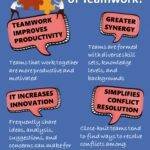
5 Stages of Group Development
This process of learning to work together effectively is known as team development. Research has shown that teams go through 5 definitive stages of group development.
Bruce Tuckman, an educational psychologist, identified a five-stage development process that most teams follow to become high performing. He called the stages: forming, storming, norming, performing, and adjourning.
Most high-performing teams go through five stages of team development
Forming stage
The forming stage involves a period of orientation and getting acquainted. Uncertainty is high during this stage, and people are looking for leadership and authority. A member who asserts authority or is knowledgeable may be looked to take control. Team members are asking such questions as “What does the team offer me?” “What is expected of me?” “Will I fit in?”
Most interactions are social as members get to know each other.
Storming stage
The storming stage is the most difficult and critical stage to pass through. It is a period marked by conflict and competition as individual personalities emerge.
Team performance may actually decrease in this stage because energy is put into unproductive activities. Members may disagree on team goals, and subgroups and cliques may form around strong personalities or areas of agreement.
To get through this stage, members must work to overcome obstacles, to accept individual differences, and to work through conflicting ideas on team tasks and goals. Teams can get bogged down in this stage.
Failure to address conflicts may result in long-term problems.
Norming stage
If teams get through the storming stage, conflict is resolved and some degree of unity emerges. In the norming stage, consensus develops around who the leader or leaders are, and individual member’s roles.
Interpersonal differences begin to be resolved, and a sense of cohesion and unity emerges. Team performance increases during this stage as members learn to cooperate and begin to focus on team goals.
However, the harmony is precarious, and if disagreements re-emerge the team can slide back into storming.
Performing stage
In the performing stage, consensus and cooperation have been well-established and the team is mature, organized, and well-functioning. There is a clear and stable structure, and members are committed to the team’s mission.
Problems and conflicts still emerge, but they are dealt with constructively. (We will discuss the role of conflict and conflict resolution in the next section). The team is focused on problem solving and meeting team goals.
Adjourning stage
In the adjourning stage, most of the team’s goals have been accomplished. The emphasis is on wrapping up final tasks and documenting the effort and results.
As the work load is diminished, individual members may be reassigned to other teams, and the team disbands. There may be regret as the team ends, so a ceremonial acknowledgement of the work and success of the team can be helpful.
If the team is a standing committee with ongoing responsibility, members may be replaced by new people and the team can go back to a forming or storming stage and repeat the development process.
(Reference: https://socialsci.libretexts.org/)


